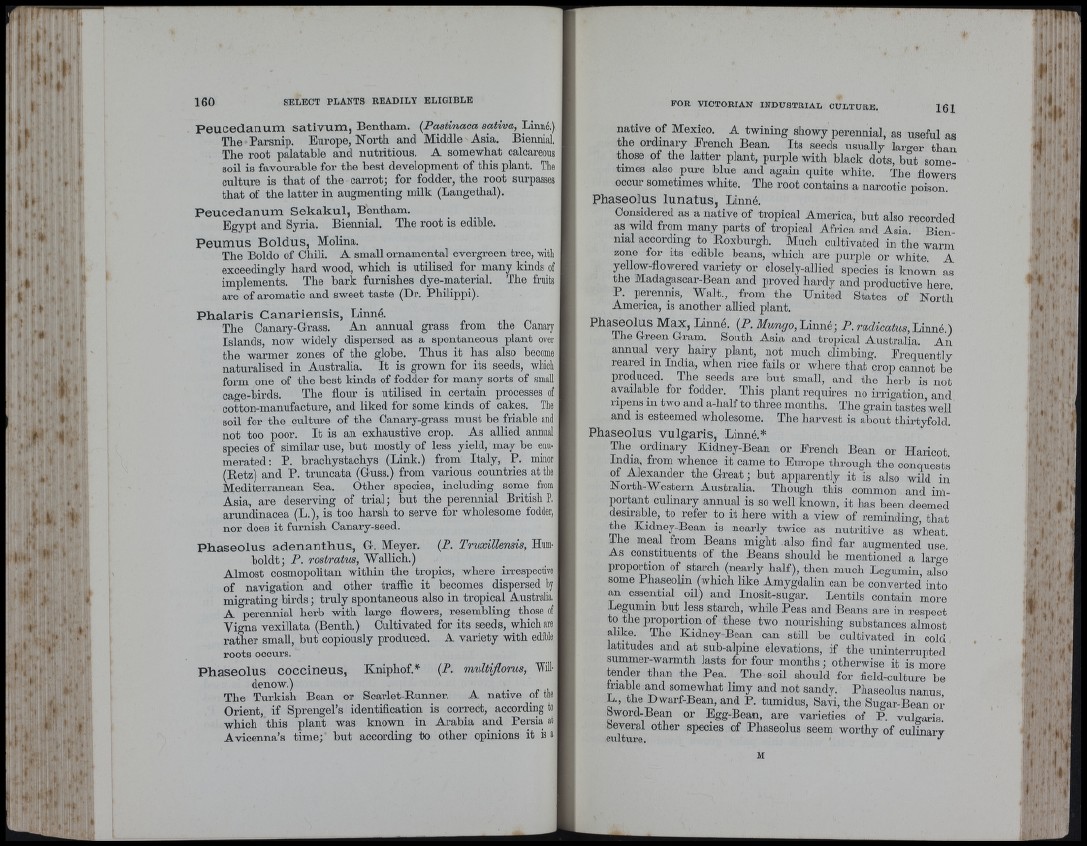
m ï ï
î• -Î* } {
, >■ .
î j ‘ '>■ ' { *M'
i ? ' - ■
i ' * ’ h I ’ ' r
I -1
>1 1 «
' ■■ .1
t ïï
I
i
i 11
i I
' i.
Peucedanum sativum, Bentham. (Fastinaca sativa, Linné.)
The Parsnip. Europe, North and Middle Asia. Biennial
The root palatable and nutritious. A somewhat calcareous
soil is favourable for the best development of this plant. The
culture is that of the carrot ; for fodder, the root surpasses
that of the latter in augmenting milk (Langethal).
Peucedanum Sekakul, Bentham,
Egypt and Syria. Biennial. The root is edible.
Peumus Boldus, Molina.
The Boldo of Chili. A small ornamental evergreen tree, with
exceedingly hard wood, which is utilised for many kinds of
implements. The bark furnislies dye-material. The fruits
are of aromatic and sweet taste (Dr. Philippi).
Phalaris Canariensis, Linné.
The Canary-Crass. An annual grass from the Canary
Islands, now widely dispersed as a spontaneous plant over
the warmer zones of the globe. Thus it has also become
naturalised in Australia. I t is grown for its seeds, whicli
form one of tbe best kinds of fodder for many sorts of small
cage-birds. Tbe flour is utilised in certain processes of
cotton-manufacture, and liked for some kinds of cakes. The
soil for tbe culture of the Canary-grass must be friable and
not too poor. I t is an exhaustive crop. As allied annual
species of similar use, but mostly of less yield, may be enumerated;
P. bracliystachys (Link.) from Italy, P. minor
(Retz) and P. truncata (Cuss.) from various countries at the
Mediterranean Sea, Other species, including some from
Asia, are deserving of trial; but the perennial British P,
arundinacea (L.), is too harsh to serve for wholesome fodder,
nor does it furnish Canary-seed.
Phaseolus adenanthus, G. Meyer. (P. Truxillensis, Humboldt;
P. rostratus, Wallich.)
Almost cosmopolitan within tlie tropics, where irrespective
of navigation and other traffic it becomes dispersed by
migrating birds ; truly spontaneous also in tropical A.ustralia,
A perennial herb with large flowers, resembling those of
Vigna vexillata (Benth.) Cultivated for its seeds, which are
rather small, but copiously produced. A variety with edible
roots occurs.
Phaseolus coccineus, Kniphof.* {P. multiflorus, Willdenow.)
The Turkish Bean or Scarlet-Runner. A native of the
Orient, if Sprengel’s identification is correct, according to
which this plant was known in Arabia and Persia at
Avicenna’s time; but according to other opinions it is a
native of Mexico. A twining showy perennial, as useful as
the ordinary French Bean. Its seeds usually larger than
those of the latter plant, purple with black dots, but sometimes
also pure blue and again quite white. Tbe flowers
occur sometimes white. The root contains a narcotic poison.
Phaseolus lunatus, Linné.
Considered as a native of tropical America, but also recorded
as wild from many parts of tropical Africa and Asia. Biennial
according to Roxburgh. Much cultivated in the warm
zone for its edible beans, which are purple or wliite A
yellow-flowered variety or closely-allied species is known as
the Madagascar-Bean and proved hardy and productive here.
P. perennis, Walt., from the United States of North
America, is another allied plant.
Linné. {P. Mungo, Linné ; P. radicatus,4Anxi(i.')
Ihe Green Gram. South Asia and tro))ical Australia, An
annual very hairy plant, not much climbing. Frequent]v
reared in India, when rice fails or where that crop cannot be
produced. The seeds are but small, and tlie herb is not
available for fodder. Tdiis plant requires no irrigation and
ripens in two and a-lialf to three months. The graii i tastes well
and is esteemed wholesome. The harvest is about thirtyfold.
Phaseolus vulgaris, Linné.*
The_ ordinary Kidney-Bean or Frencli Bean or Haricot
India, from whence it came to Europe through the conquests
of Alexander the Great; but ap})arently it is also wild in
Noi til"Western Anstralia. ïliougli tliis coin.nion and im-
portant culinary annual is so well known, it Las been deemed
desiralile, to refer to it here with a view of reminding, that
the Kidney-Bean is nearly twice as nutritive as wheat
The meal from Beans might also find far augmented use’
As constituents of the Beans should be mentioned a lar^r^
proportion of starch (nearly half), then much Legumin ako
some Phaseolin (which like Amygdalin can be converted into
an essential oil) and Inosit-sugar. Lentils contain more
Legumin but less starch, while Peas and Beaus are in respect
to the i)roportion of these two nourishing substances almost
alike. The Kidney-Bean can still be cultivated in cold
latitudes and at sub-alpine elevations, if the uninterrupted
summer-warmth lasts for four months ; otherwise it is more
tender than the Pea. The soil should for field-culture be
friable and somewhat limy and not sandy. Phaseolus nanus
L., the Dwarf-Bean, and P. tumidus, Savi, the Sugar-Bean or
Sword-Bean or Egg-Bean, are varieties of P. vukaris
Several otlier species of Phaseolus seem worthy of culmarv
culture. ' ^
M
■iv
'